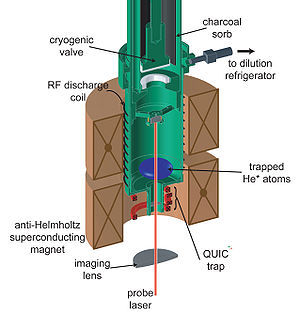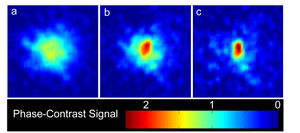Difference between revisions of "BEC"
(→Metastable Helium BEC) |
|||
| Line 13: | Line 13: | ||
We have utilized buffer-gas methods to demonstrate Bose-Einstein condensation of 4He* without the use of laser pre-cooling. These methods are readily extendable to any paramagnetic species with typical collisional parameters that allow for efficient evaporative cooling, significantly extending the scope of ultracold atom/molecule research. The experiment takes place in a G-10 cell, coaxially inside the bore of a 4 T deep superconducting anti-Helmholtz magnetic trap and thermally anchored to a dilution refrigerator. 4He* is excited via RF discharge with an efficiency of 10^-5 from a 4He buffer gas and cooled to the refrigerator temperature by collisions with the remaining buffer gas. The buffer gas is cryo-pumped to a charcoal sorb, leaving approximately 10^11 4He* atoms trapped in the magnetic field. The atom cloud is then evaporatively cooled to 1 mK by surface-induced evaporation and transferred to a tightly confining, superconducting quadrupole-Ioffe configuration trap to prevent Majorana losses. Further evaporative cooling using a RF knife leads to BEC formation at a temperature of 5 uK with approximately 10^6 atoms remaining. Further evaporative cooling creates a nearly-pure condensate of 2-300,000 atoms. Atoms are detected in time-of-flight using phase-contrast imaging. | We have utilized buffer-gas methods to demonstrate Bose-Einstein condensation of 4He* without the use of laser pre-cooling. These methods are readily extendable to any paramagnetic species with typical collisional parameters that allow for efficient evaporative cooling, significantly extending the scope of ultracold atom/molecule research. The experiment takes place in a G-10 cell, coaxially inside the bore of a 4 T deep superconducting anti-Helmholtz magnetic trap and thermally anchored to a dilution refrigerator. 4He* is excited via RF discharge with an efficiency of 10^-5 from a 4He buffer gas and cooled to the refrigerator temperature by collisions with the remaining buffer gas. The buffer gas is cryo-pumped to a charcoal sorb, leaving approximately 10^11 4He* atoms trapped in the magnetic field. The atom cloud is then evaporatively cooled to 1 mK by surface-induced evaporation and transferred to a tightly confining, superconducting quadrupole-Ioffe configuration trap to prevent Majorana losses. Further evaporative cooling using a RF knife leads to BEC formation at a temperature of 5 uK with approximately 10^6 atoms remaining. Further evaporative cooling creates a nearly-pure condensate of 2-300,000 atoms. Atoms are detected in time-of-flight using phase-contrast imaging. | ||
| − | + | =Two-body collisions in Thulium and Erbium= | |
Since producing our 4He* BEC we have been investigating two-body atom-atom collisional properties of the "submerged-shell" rare-earth atoms Thulium and Erbium. Previous research in our lab indicated that the submerged-shell nature of these atoms gives rise to strong suppression of inelastic processes during atom-helium collisions. Similar suppression of inelastic collisions in atom-atom collisions would permit efficient evaporative cooling and make these atoms excellent candidates for new quantum degenerate gases, accessible using our new buffer-gas BEC approach. | Since producing our 4He* BEC we have been investigating two-body atom-atom collisional properties of the "submerged-shell" rare-earth atoms Thulium and Erbium. Previous research in our lab indicated that the submerged-shell nature of these atoms gives rise to strong suppression of inelastic processes during atom-helium collisions. Similar suppression of inelastic collisions in atom-atom collisions would permit efficient evaporative cooling and make these atoms excellent candidates for new quantum degenerate gases, accessible using our new buffer-gas BEC approach. | ||
| − | + | =Recent Publications= | |
*[[Media:A buffer-gas cooled Bose-Einstein condensate, S. C. Doret, C. B. Connolly, W. Ketterle, and J. M. Doyle, to be published by Phys. Rev. Lett. (2009).]]. | *[[Media:A buffer-gas cooled Bose-Einstein condensate, S. C. Doret, C. B. Connolly, W. Ketterle, and J. M. Doyle, to be published by Phys. Rev. Lett. (2009).]]. | ||
Revision as of 11:19, 29 July 2009
Contents
Buffer-Gas BEC project
People
- Charlie Doret
- Colin Connolly
- Yat Shan Au
Overview
Despite innumerable experimental advances, research with degenerate Bose and Fermi gases has remained limited to only a handful of atomic species since its inception due to the field's reliance on laser pre-cooling as the first step towards quantum degeneracy. Developmening new cooling methods applicable to a wider range of atoms and also to molecules is thus important for taking full advantage of scientific opportunities in new areas.
Metastable Helium BEC
We have utilized buffer-gas methods to demonstrate Bose-Einstein condensation of 4He* without the use of laser pre-cooling. These methods are readily extendable to any paramagnetic species with typical collisional parameters that allow for efficient evaporative cooling, significantly extending the scope of ultracold atom/molecule research. The experiment takes place in a G-10 cell, coaxially inside the bore of a 4 T deep superconducting anti-Helmholtz magnetic trap and thermally anchored to a dilution refrigerator. 4He* is excited via RF discharge with an efficiency of 10^-5 from a 4He buffer gas and cooled to the refrigerator temperature by collisions with the remaining buffer gas. The buffer gas is cryo-pumped to a charcoal sorb, leaving approximately 10^11 4He* atoms trapped in the magnetic field. The atom cloud is then evaporatively cooled to 1 mK by surface-induced evaporation and transferred to a tightly confining, superconducting quadrupole-Ioffe configuration trap to prevent Majorana losses. Further evaporative cooling using a RF knife leads to BEC formation at a temperature of 5 uK with approximately 10^6 atoms remaining. Further evaporative cooling creates a nearly-pure condensate of 2-300,000 atoms. Atoms are detected in time-of-flight using phase-contrast imaging.
Two-body collisions in Thulium and Erbium
Since producing our 4He* BEC we have been investigating two-body atom-atom collisional properties of the "submerged-shell" rare-earth atoms Thulium and Erbium. Previous research in our lab indicated that the submerged-shell nature of these atoms gives rise to strong suppression of inelastic processes during atom-helium collisions. Similar suppression of inelastic collisions in atom-atom collisions would permit efficient evaporative cooling and make these atoms excellent candidates for new quantum degenerate gases, accessible using our new buffer-gas BEC approach.

